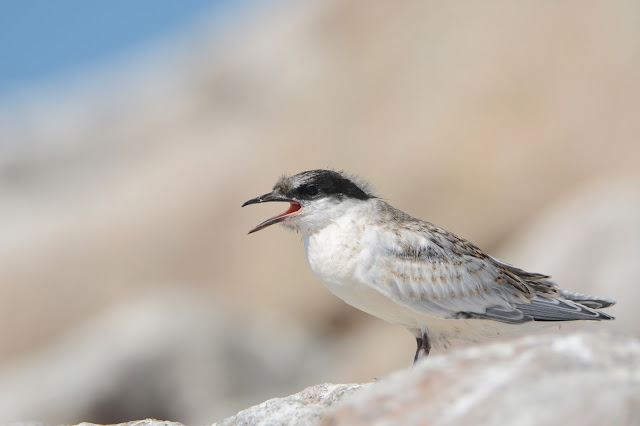Another busy week! Having thousands of birds on Rockabill is fairly standard over the summer months, but this week we had loads of people out here too! Given that there's usually only two of us out here, a bit of social interaction at this stage might be no harm as we we look to ease ourselves back into society at the end of August!
First of all we were visited by the Roseate Tern team from RSPB Coquet Island - Paul Morrison, Wes Davies and Tom Cadwallender. Coquet Island lies off the Northumberland coast in England and is home to 102 pairs of Roseate Terns (and counting!). The Coquet team's visit was facilitated by the current EU LIFE project to protect and expand the breeding range of the Roseate Tern in Ireland and Britain, and provided a great chance for the Rockabill and Coquet teams to meet up and 'talk Terns' and exchange knowledge on how we can continue to improve the fortunes of the Roseate Tern.
Check out the Coquet Island twitter account and website to keep up to date with all of the goings-on at Coquet and to see a live feed of how their Roseate Terns are getting on:
 |
| The Rockabill and Coquet Roseate Tern teams together for the first time. |
It was also a great chance for the Rockabill team to sample the "Roseate Tern IPA", made by the 'From the Notebook' label which is on sale in the UK and from which a portion of sales go directly to the Roseate Tern project on Coquet. The label features a beautiful picture of a Roseate Tern with Coquet Island in the background, a short description of the species and it even has a pink/roseate cap! I had heard of the Roseate Tern IPA a couple of weeks ago, and let's just say it lived up to expectations!
 |
| Roseate Tern IPA on Rockabill! |
The Coquet guys left on Thursday and on Friday we were delighted to welcome another group of visitors on Friday. It was great to meet Daniel Piec and Chantal Macleod-Nolan who are overseeing and co-ordinating the
Roseate Tern LIFE project as part of the RSPB, as well as wardens and staff from a number of
Tern colonies in Northern Ireland and Wales who came to see how we do things on Rockabill and how successful our work has been to date. (and
Paddy from Kilcoole came out too, just 'cos Rockabill is the place to be!).
Given that every tern colony is different it was great to hear about other colonies and how they're faring this season, the different mix of species that each colony has, and the different problems each colony has and how they're tackled. These kinds of information-exchanges, however formal or informal, can be really valuable in the long run. Hopefully our visitors left with a renewed enthusiasm to attract Roseate Terns to their own colony and help this fantastic seabird become less rare in the coming years!
To
keep up to date with the Roseate Tern LIFE project check out the facebook and twitter pages at the link below:
 |
| Our guests getting a tour of the island. (picture by Daniel Piec) |
 |
| The Rockabill team and our colleagues from the Roseate Tern LIFE project. (Pic via Chantal Macleod-Nolan & Usna Keating) |
In addition to the Roseate Tern stuff we also had Saskia Wischnewski with us for most of the week. Saskia is studying seabird ecology at UCC and is currently carrying out work on behalf of Birdwatch Ireland which aims to look at where seabirds go to feed in the Irish Sea. She deployed a number of tags on our Kittiwakes and got some fascinating data with many of our birds heading far out to the north east in search of food to feed their chicks.
 |
| Saskia removing a special tag that tracked the movements of one of the Rockabill Kittiwakes. Tag attached and picture taken under NPWS license. |
And last but not least we had a changing of the guard recently. David Kinchin Smith has departed us to take up his dream job in the South Atlantic conserving birds on Gough Island - so his watch has ended. It was a pleasure working with David and on behalf of everyone here we want to wish him and Kilcoole's Em Witcutt the very best of luck on Gough and we look forward to tracking their progress in the coming months.
 |
| Brian Burke and David Kinchin-Smith - Rockabill Wardens for 2016, just before David departed! |
We are also delighted to welcome Shane Somers as the new warden on Rockabill. Unfortunately the Baltray Little Terns failed to breed this year, but Shane will definitely get his Tern-fix out here on Rockabill over the coming weeks and months! It's a big ask to begin work at such a large Tern colony in the middle of the season - the busiest time - but he has risen to the occasion and the Terns continue to be well looked after!
 |
| Shane Somers- the new Rockabill warden! (pic by Matthew Byrne) |
























